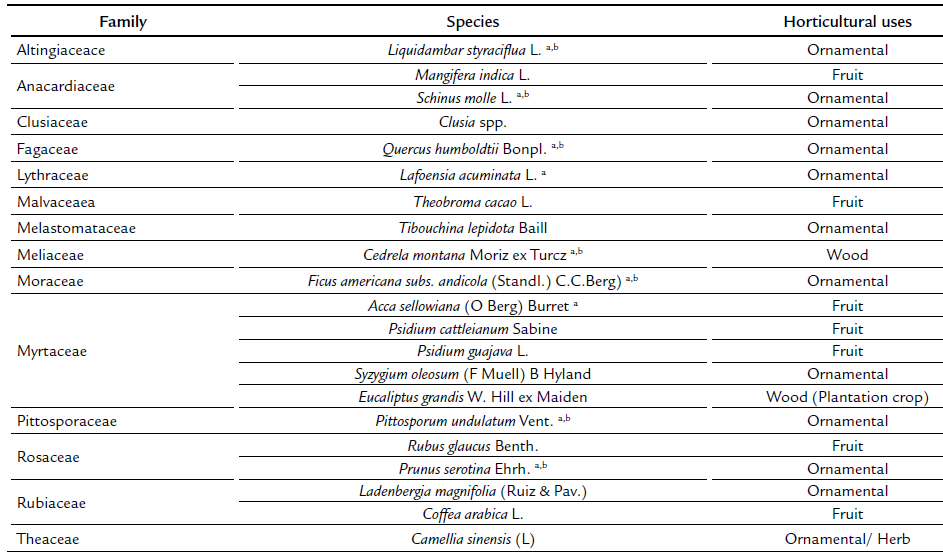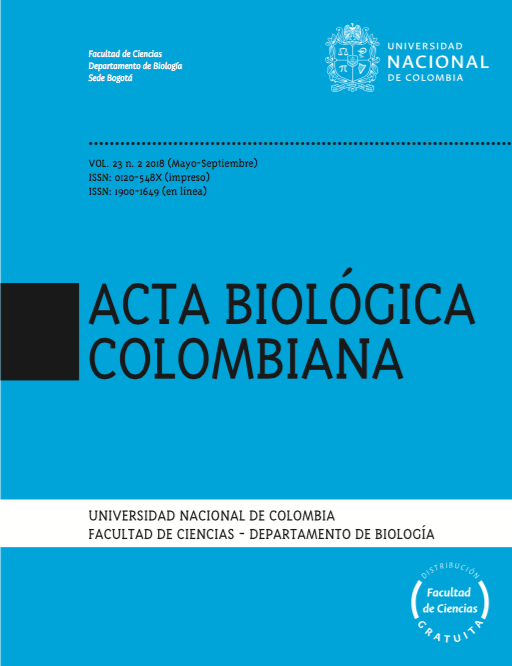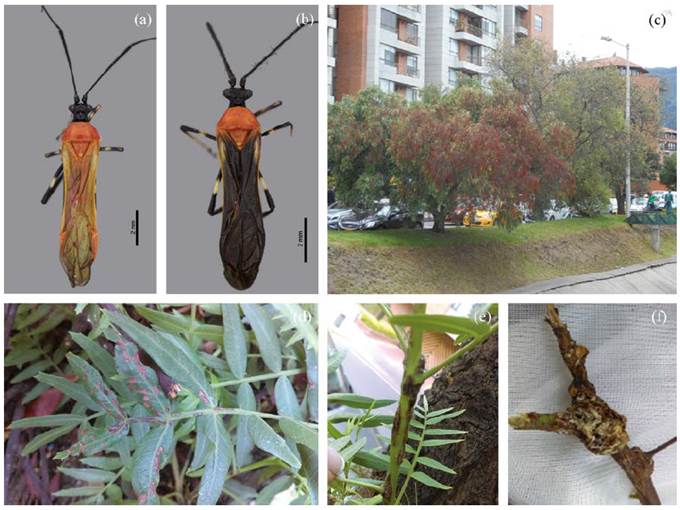New plant associations for Monalonion velezangeli (Hemiptera: Miridae) in green urban areas of Bogotá (Colombia)
Nuevas asociaciones de plantas para Monalonion velezangeli (Hemiptera: Miridae) en áreas verdes urbanas de Bogotá (Colombia)
DOI:
https://doi.org/10.15446/abc.v23n2.69374Palabras clave:
bug, Míridos, phytophagous, urban ecosystem, urban trees. (en)árboles urbanos, ecosistema urbano, fitófago, míridos. (es)
Descargas
Monalonion velezangeli Carvalho and Costa (Hemiptera: Miridae) is a polyphagous plant bug recognized as one of the most important pest species of coffee and avocado in rural regions of Colombia. M. velezangeli is reported for the first time in green urban areas in the high Andean city of Bogotá (Colombia). Specimens were collected on eight species of urban trees planted in the city, of which five represent new plant associations for M. velezangeli. The plant species Schinus molle L. (Anacardiaceae) is for the first time reported as new host plant damaged by M. velezangeli under urban conditions.
Monalonion velezangeli Carvalho and Costa (Hemiptera: Miridae) es un mírido polífago reconocido como una de las especies plaga más importantes del café y el aguacate en regiones rurales de Colombia. M. velezangeli es reportado por primera vez en áreas verdes urbanas en la cordillera de los Andes en la ciudad de Bogotá (Colombia). Los especímenes fueron recolectados en ocho especies de árboles plantados en la ciudad, de los cuales cinco representan nuevas asociaciones de M. velezangeli. La especie Schinus molle L. (Anacardiaceae) es por primera vez reportada como nueva planta hospedera afectada por M. velezangeli bajo las condiciones urbanas.
Recibido: 11 de diciembre de 2017; Revisión recibida: 24 de febrero de 2018; Aceptado: 13 de abril de 2018
ABSTRACT
Monalonion velezangeli Carvalho and Costa (Hemiptera: Miridae) is a polyphagous plant bug recognized as one of the most important pest species of coffee and avocado in rural regions of Colombia. M. velezangeli is reported for the first time in green urban areas in the high Andean city of Bogotá (Colombia). Specimens were collected on eight species of urban trees planted in the city, of which five represent new plant associations for M. velezangeli. The plant species Schinus molle L. (Anacardiaceae) is for the first time reported as new host plant damaged by M. velezangeli under urban conditions.
Keywords:
Mírid bug, phytophagous, urban ecosystem, urban trees.RESUMEN
Monalonion velezangeli Carvalho and Costa (Hemiptera: Miridae) es un mírido polífago reconocido como una de las especies plaga más importantes del café y el aguacate en regiones rurales de Colombia. M. velezangeli es reportado por primera vez en áreas verdes urbanas en la cordillera de los Andes en la ciudad de Bogotá (Colombia). Los especímenes fueron recolectados en ocho especies de árboles plantados en la ciudad, de los cuales cinco representan nuevas asociaciones de M. velezangeli. La especie Schinus molle L. (Anacardiaceae) es por primera vez reportada como nueva planta hospedera afectada por M. velezangeli bajo las condiciones urbanas.
Palabras clave:
árboles urbanos, ecosistema urbano, fitófago, míridos.Monalonion Herrich-Schaeffer is a genus of the subfamily Bryocorinae (tribe Monaloniini) with Neotropical distribution (Namyatova et al., 2016), which comprises 16 valid species (Schuh, 2002; Schuh, 2013). In Colombia, there are six recorded species (Distant, 1917; Schuh, 2002; Giraldo and Benavides, 2012; Schuh, 2013), although a detailed survey of those present in the country and their distributions has never been carried out. Monalonion species from Colombia, known exclusively from rural areas, are: M. annulipes Signoret, M. atratum Distant, M. columbiensis Carvalho, M. dissimulatum Distant, M. itabunensis Carvalho, and M. velezangeli Carvalho and Costa (Distant, 1917; Carvalho, 1972; Carvalho, 1984; Carvalho and Costa, 1988; Schuh, 2002; Schuh, 2013).
Some of these Monalonion species are important pest species of cacao (Theobroma cacao L., Malvaceae) (Abreu, 1977), guava (Psidium guava L., Myrtaceae) and avocado (Persea americana Mill., Lauraceae) in Central and South America (Distant, 1917; Wille, 1944; Wheeler, 2000). Monalonion velezangeli is also a pest of the economic importance of coffee (Coffea arabica L., Rubicaeae) in Colombia (Giraldo and Benavides, 2012).
Monalonion velezangeli was described from specimens collected in 1984 in Antioquia on avocado orchards (Carvalho and Costa, 1988). Monalonion velezangeli is a polyphagous plant bug associated in Colombia with 14 plant species of Myrtaceae (5), Rubiaceae (2), Lythraceae (1), Clusiaceae (1), Rosaceae (1), Malvaceae (1), Melastomataceae (1), Anacardiaceae (1), and Theaceae (1), which include economically important fruit, ornamental, and forest plantations (Giraldo and Benavides, 2012; Londoño et al., 2014; Rodas et al., 2014)(Table 1).
Species with a indicates all the plants present in Bogotá; b New plant association.Table 1: Plant associations of Monalonion velezangeli Carvalho and Costa (Hemiptera: Miridae) in Colombia.

Monalonion velezangeli is characterized by its mostly black and dark yellow body, the presence of two or more red markings on the forewing membrane, and the white band on the femora (Carvalho and Costa, 1988; Giraldo et al., 2010; Fig 1a-1b). It might be confused with M. parviventre Herrich-Schaeffer by the red spots on the forewing membrane and with M. atratum by the color of the femora (Carvalho, 1972; Carvalho and Costa, 1988).
Figure 1: (a) Female of Monalonion velezangeli; (b) Male of Monalonion velezangeli; (c) Urban tree strongly affected by Monalonion velezangeli; (d) Dried leaves with reddish-brownish coloration; (e) Twig with necrotic lesions; (f) Twig malformation affecting bud development.
Many species of Monalonion exhibit polychromatism (Carvalho, 1972; Costa et al., 2008), including M. velezangeli (e.g., Giraldo et al., 2010), as exemplified by the coloration of the type series of M. velezangeli , in which most of the paratypes are mostly dark yellow in contrast to the mostly dark holotype (Carvalho and Costa 1988; J.A. Quiroz, pers. comm.).
Bogotá is a city located in the high Andes of Colombia at 2650 meters above sea level (4°35'56''N; 74°04'51''W). This is the largest city of Colombia with over 7 million people and approximately 1637 km2 of extension. Due to this high elevation, Bogotá has a cold climate (average 17 °C) with two wet periods in the year occurring between March to May and September to November. Bogotá has many public and private green areas including parks, greenways, wetlands, and others (Alcaldía Mayor de Bogotá, 2017).
Entomological surveys focusing on urban trees planted in public parks and greenways in the northern portion of Bogotá were carried out irregularly, from May 2016 to March 2018, using sweep nets and entomological aspirators.
All specimens were identified using original descriptions and taxonomic keys (Carvalho, 1972; Carvalho, 1984; Carvalho and Costa, 1988). Collected specimens exhibit polychromatism, as documented before (Carvalho and Costa, 1988). Examined specimens are as follow 3 males and 1 nymph on Liquidambarstyraciflua, 2 males, 1 nymph on Pittosporum undulatum; 1 male on Ficus americana subs. andicola; 2 males and 2 females on Quercus humboldtii; 1 nymph on Acca sellowiana; 1 female on Prunus serotina; 6 males, 5 females and 1 nymph on Lafoensia acuminata; 6 males and 1 nymphs Schinus molle; 1 nymph in Cedrela montana; all deposited in the Entomology collection of the Museo Javeriano de Historia Natural Lorenzo Uribe S.J., of the Pontificia Universidad Javeriana (MUPJ_ENT), with catalog numbers MPUJ_ENT 0058309-MPUJ_ENT 0058344.
Monalonion velezangeli was found on different botanical species planted in public green areas of Bogotá. This is also the first report of this mirid species in an urban ecosystem at such a high altitude, which is noteworthy given that in Colombia most published records are below 2000 ma.s.l (Ramírez-Cortés et al., 2008) with occasional ones up to 2300 ma.s.l. in rural areas (Torres Jaimes et al., 2012). These records from Bogotá might represent recent introductions of M. velezangeli, and if so, they could be further evidence that environmental conditions are changing in Bogotá.
We also document for the first time the association of M. velezangeli with five new plant families (Pittosporaceae, Moraceae, Altingiaceae, Fagaceae and Meliaceae), increasing the number of reported species known for Colombia and other Andean countries from 14 to 19 (Table 1). Monalonion velezangeli was also collected on Lafoensia acuminata (Lythraceae), which was recorded previously as a host plant for this species (Londoño et al., 2014). Given the complex relationship between plants and Miridae (Wheeler, 2001), it is usually difficult to clearly assess if a plant species truly represents a host plant. Occasional occurrences of adults on various plants might represent visitors or indicate that they use the plant as an alternative feeding resource. In Bogotá, L. acuminata, L. styraciflua and S. molle can be considered host plants of M. velezangeli because we consistently found nymphs on these plants. Because nymphs cannot fly to reach other trees, we assume that their presence in a given plant species are an indication of true host plants, because these plants species might support nymphal development (Wheeler, 2016). Further studies are required to assess which plant species are better hosts for the reproduction of M. velezangeli.
Among the new plant species associated with M. velezangeli in Bogotá, the false pepper (S. molle) was observed injured by this plant bug. The damage was observed on the leaves and twigs of the tree, especially on young tissues; it is characterized by the presence of reddish-brownish necrotic lesions around the insect feeding site. As a result, dried leaves and twigs begin to appear (Fig. 1c-1e). These symptoms resemble those reported by Rodas et al. (2014) on Eucaliptus grandis W. Hill ex Maiden, mainly on young trees, and by Giraldo and Benavides (2012) in other hosts such as guava, avocado and coffee. Moreover, tissue malformations are commonly observed, particularly on young stems, inhibiting the formation of new buds (Fig. 1f). Both nymphs and adults seem to be responsible for the damage to S. molle, even when low levels of infestation by M. velezangeli were recorded. It is possible that morphological damage on this host tree is also related with secondary infections by phytopathogens. Recently it has been observed symptoms related to pathogenic infection by Verticillum spp. in shoots on several population of S. molle in green urban spaces in Bogotá (G.L. Sánchez, pers. comm.). Further studies to test this hypothesis are needed as well as studies that evaluate if the new plants species associated with M. velezangeli are used as feeding resources or also as oviposition substrates. Moreover, studies on the biology of M. velezangeli and its role as a pest in urban trees in Bogotá are necessary.
ACKNOWLEDGMENT
Authors thank the Alcaldía Mayor de Bogotá and Jardín Botánico de Bogotá José Celestino Mutis for financial support and to Alexander Bustos for critical reading of this manuscript.
REFERENCES
Referencias
Abreu JM. Mirídeos tropicais associados ao cacaueiro. In: Lavebre EM, editor. Les mirides du cacaoyer. Paris: Institut français du cafe et du cacao; 1977. p. 85-106.
Alcaldía Mayor de Bogotá. Ubicación de la ciudad [Internet] 2017 Nov. Avaliable in: http://www.bogota.gov.co/ciudad/ubicacion. Cited: 17 Sep 2017.
Burckhardt D, Ouvrard D, Queiroz D, Percy D. Psyllid host-plants (Hemiptera: Psylloidea): resolving a semantic problem. Fla Ent. 2014;97:242–246. Doi:10.1653/024.097.013
Carvalho JC. Mirídeos Neotropicais, CXLVI: Gênero Monalonion H.-S., 1853 (Hemiptera). An Acad Bras Cienc. 1972;44:119–143.
Carvalho JC. Miridos neotropicales, CCXLIII: Nuevas especies de la República de Colombia (Hemiptera). Rev Gallesciencia. 1984;1:11–20.
Carvalho JC, Costa LA. Mirídeos Neotropicais, CCXCVII: duas novas espécies do gênero Monalonion Herrich-Schaeffer (Hemiptera). Rev Bras Biol. 1988;48:893–896.
Costa LA, Chérot F, Carpintero D. Hétéroptères Miridae de Guyane française: Liste préliminaire, descriptions de taxa nouveaux et données additionnelles. Ann Soc Entomol Fr (n.s). 2008;44:345–371.
Distant WL. On some Rhynchota of economic importance from Colombia. Bull Ent Res. 1917;7:381–382. Doi:10.1017/S0007485300018071.
Giraldo M, Benavides P. Conozca los hospedantes, sitios de alimentación y oviposición de la chinche de la chamusquina del café [Internet] 2012 April. Avaliable in; http://biblioteca.cenicafe.org/bitstream/10778/332/1/avt0418.pdf. Cited: 17 September 2017.
Giraldo M, Benavides P, Villegas C. Aspectos morfológicos y biológicos de Monalonion velezangeli Carvalho & Costa (Hemiptera: Miridae) en café. Cenicafé. 2010;61:195-205.
Londoño ME, Kondo T, Carabalí A, Varón EH, Caicedo AM. Insectos y ácaros. In: Bernal J, Díaz C, Osorio C, Tamayo A, Osorio W, Córdoba O et al., editor(s). Manual técnico actualización tecnológica y buenas prácticas agrícolas (BPA) en el cultivo del aguacate. Colombia: Suimagen Creativa S.A.S; 2014. p. 228-256.
Mound LA. Homologies and host-plant specificity: recurrent problems in the study of thrips. Fla Ent. 2013; 96:318–322. Doi:10.1653/024.096.0250
Namyatova AA, Konstantinov FV, Cassis G. Phylogeny and systematics of the subfamily Bryocorinae based on morphology with emphasis on the tribe Dicyphini sensu Schuh, 1976. Zool J Linn Soc. 2016;176:36–136. Doi:10.1111/zoj.12311.
Ramírez-Cortés HJ, Gil-Palacio ZN, Benavides-Machado P, Bustillo-Pardey AE. Monalonion velezangeli. La chinche de la chamusquina del café [Internet] 2008 Jan. Avaliable in: http://www.cenicafe.org/es/publications/avt0367.pdf. Cited: 17 Sep 2017.
Rodas CA, Serna R, Hurley BP, Bolaños MD, Granados GM, Wingfield MJ. Three new and important insect pests recorded for the first time in Colombian plantations. South For. 2014;76:245–252.
Schuh RT. On-line systematic catalog of plant bugs (Insecta: Heteroptera: Miridae) [Internet] 2002-2013. Avaliable in: http://research.amnh.org/pbi/catalog/. Cited: 17 August 2017.
Torres Jaimes LF, Correa GA, Cartagena JR, Monsalve DA, Londoño ME. Relationship of Monalonion velezangeli Carvalho & Costa (Hemiptera: Miridae) with the phenology of avocado (Persea americana Mill., cv. Hass). Rev Fac Nal Agr Medellín. 2012;65:6659-6665.
Wille JE. Insect pest of cacao in Peru. Trop Agric Trin. 1944;21:143-144.
Wheeler AG. Plant bugs (Miridae) as plant pests. In: Schaefer CW, Panizzi AR, editor(s). Heteroptera of economic importance. United States: CRP Press; 2000 p. 37-83.
Wheeler AG. Biology of the Plant Bugs (Hemiptera: Miridae): pests, predators, opportunists. Ithaca, NY: Cornell University Press; 2001. p. 176, 253-329.
Wheeler AG. Liorhyssus hyalinus (F.) (Hemiptera: Rhopalidae) in the Western United States: new host records, host-plant range, and comments on use of the term “host plant.” Proc Entomol Soc Wash. 2016;118:115–128. Doi:10.4289/0013-8797.118.1.115.
Cómo citar
APA
ACM
ACS
ABNT
Chicago
Harvard
IEEE
MLA
Turabian
Vancouver
Descargar cita
CrossRef Cited-by
1. Jean Gamboa, Lucía Pérez-Benavides, Esaú Ospina-Peñuela, Francisco Serna, Gennaro Viggiani. (2024). A new species of Uscanoidea Girault (Hymenoptera, Trichogrammatidae), an egg parasitoid of Monalonion dissimulatum Distant (Hemiptera, Miridae). Journal of Hymenoptera Research, 97, p.191. https://doi.org/10.3897/jhr.97.111008.
2. Diana Isabel Rendón-Mera, Daniel Burckhardt, Juliana Durán, Valentina Ocampo, Sergio Andrés Vargas-Fonseca. (2024). The jumping plant-lice (Hemiptera, Psylloidea) in Urban Green Spaces of Bogotá (Colombia), with descriptions of two new species and redescription of Mastigimas colombianus Burckhardt, Queiroz and Drohojowska. ZooKeys, 1209, p.199. https://doi.org/10.3897/zookeys.1209.117368.
3. Lucio Navarro-Escalante, Pablo Benavides, Flor E. Acevedo. (2024). Diversity of bacterial symbionts associated with the tropical plant bug Monalonion velezangeli (Hemiptera: Miridae) revealed by high-throughput 16S-rRNA sequencing . Peer Community Journal, 4 https://doi.org/10.24072/pcjournal.362.
Dimensions
PlumX
Visitas a la página del resumen del artículo
Descargas
Licencia
Derechos de autor 2018 Acta Biológica Colombiana

Esta obra está bajo una licencia internacional Creative Commons Atribución 4.0.
1. La aceptación de manuscritos por parte de la revista implicará, además de su edición electrónica de acceso abierto bajo licencia Attribution-NonCommercial-ShareAlike 4.0 (CC BY NC SA), la inclusión y difusión del texto completo a través del repositorio institucional de la Universidad Nacional de Colombia y en todas aquellas bases de datos especializadas que el editor considere adecuadas para su indización con miras a incrementar la visibilidad de la revista.
2. Acta Biológica Colombiana permite a los autores archivar, descargar y compartir, la versión final publicada, así como las versiones pre-print y post-print incluyendo un encabezado con la referencia bibliográfica del articulo publicado.
3. Los autores/as podrán adoptar otros acuerdos de licencia no exclusiva de distribución de la versión de la obra publicada (p. ej.: depositarla en un archivo telemático institucional o publicarla en un volumen monográfico) siempre que se indique la publicación inicial en esta revista.
4. Se permite y recomienda a los autores/as difundir su obra a través de Internet (p. ej.: en archivos institucionales, en su página web o en redes sociales cientificas como Academia, Researchgate; Mendelay) lo cual puede producir intercambios interesantes y aumentar las citas de la obra publicada. (Véase El efecto del acceso abierto).






















